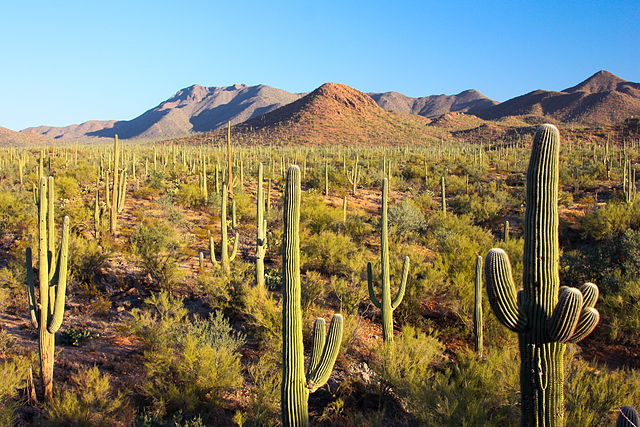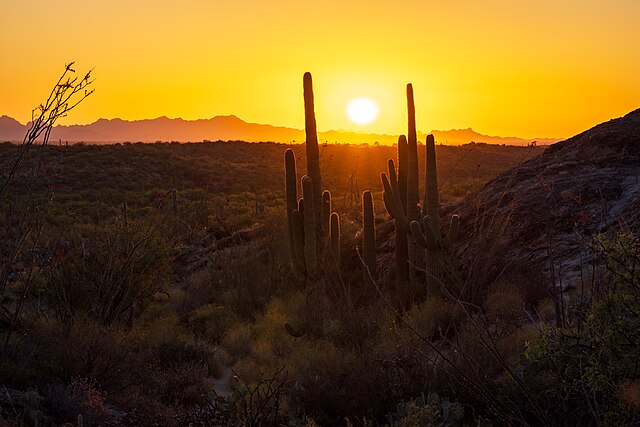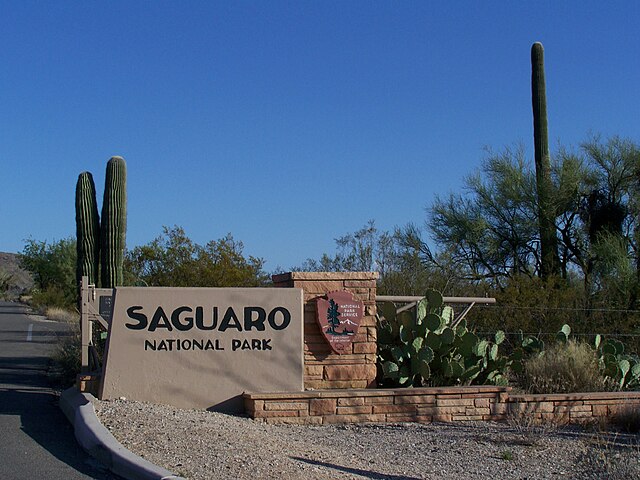Have you ever wondered what it feels like to walk among giants? Not the towering redwoods of California, but the majestic saguaro cacti that stand like sentinels across the Arizona desert. Saguaro National Park isn’t just another desert destination – it’s a living testament to the incredible adaptability of life in one of America’s most challenging environments.
Established in 1994, this remarkable park protects over 91,000 acres of pristine Sonoran Desert landscape. But here’s what makes it truly extraordinary: it’s home to the largest cacti in the United States, some reaching heights of 40 feet and living for over 200 years. These aren’t just plants; they’re ancient witnesses to centuries of desert history.
The park serves as a sanctuary for over 2,000 plant species and countless animals that have mastered the art of desert survival. From tiny hummingbirds to massive javelinas, from delicate desert wildflowers to towering organ pipe cacti, every corner of this desert wonderland tells a story of resilience and adaptation.
The Iconic Saguaro Cactus: Desert Giants
Let’s talk about the stars of the show – the saguaro cacti themselves. These magnificent plants are more than just oversized succulents; they’re entire ecosystems on stems. A single mature saguaro can weigh up to 8 tons and store enough water to last through years of drought.
What’s fascinating is their incredibly slow growth rate. A saguaro might take 15-20 years just to reach one foot in height, and they don’t grow their first arm until they’re 50-70 years old. By the time you see a multi-armed giant, you’re looking at a cactus that’s likely older than your grandparents!
These desert skyscrapers provide homes for numerous species. Gila woodpeckers and gilded flickers drill nesting holes in their trunks, while great horned owls and red-tailed hawks build nests in their arms. The saguaro’s white flowers bloom from April to June, opening at night and closing by the next afternoon – a perfect example of desert timing.
Two Districts, One Amazing Experience

Here’s something that surprises many visitors: Saguaro National Park is actually split into two separate districts, divided by the city of Tucson. Each district offers unique experiences and landscapes, making it worth visiting both if you have the time.
Tucson Mountain District (West)
The western district is your classic desert movie scene come to life. This area features the famous Desert Discovery Trail and the scenic Bajada Loop Drive. It’s generally considered more accessible for families and first-time desert visitors.
What makes the west district special is its incredible density of saguaro cacti. Some areas have over 1,000 saguaros per square mile! The terrain here is gentler, with rolling hills and valleys that create perfect photo opportunities, especially during sunrise and sunset.
The Arizona-Sonora Desert Museum, though technically not part of the park, sits right next door and makes for an excellent complement to your visit. This world-renowned facility combines zoo, botanical garden, and natural history museum all in one.
Rincon Mountain District (East)
The eastern district offers a completely different experience. Here, you’ll find more challenging terrain, higher elevations, and greater biodiversity. The Rincon Mountains rise dramatically from the desert floor, creating distinct life zones from desert scrub to pine forests.
This district is perfect for serious hikers and those seeking solitude. The Cactus Forest Loop Drive provides easy access to numerous trailheads, while the backcountry offers multi-day hiking opportunities through some of Arizona’s most pristine wilderness.
The eastern district also features the park’s visitor center, which houses excellent exhibits about desert ecology and the cultural history of the area. It’s an ideal starting point for understanding the complex relationships that make the Sonoran Desert so unique.
Best Time to Visit Saguaro National Park
Timing is everything when visiting the desert, and Saguaro National Park is no exception. The Sonoran Desert experiences distinct seasons, each offering different advantages for visitors.
Spring: The Perfect Season
March through May represents the absolute best time to visit Saguaro National Park. Temperatures are ideal for hiking, ranging from comfortable 70s to pleasant 80s during the day. This is also when the desert comes alive with wildflowers, creating a stunning carpet of color across the landscape.
Spring brings the saguaro blooming season, with beautiful white flowers crowning these desert giants. You’ll also see palo verde trees burst into yellow blooms, creating a spectacular contrast against the blue Arizona sky. Wildlife is most active during this time, making it perfect for photography and observation.
Winter: Mild and Comfortable
December through February offers another excellent window for visiting. While days can be pleasantly warm (60s-70s), nights can be surprisingly cool, sometimes dropping into the 40s. This is actually perfect for camping and extended hiking.
Winter is ideal for visitors who prefer cooler weather and want to avoid crowds. The clear, crisp air provides excellent visibility for photography, and you’ll often have trails almost to yourself. Just remember to pack layers – desert temperature swings can be dramatic.
Summer: Hot but Manageable
June through August brings serious heat to the desert, with temperatures often exceeding 100°F. However, don’t write off summer entirely. Early morning and late evening activities are still enjoyable, and you’ll experience the desert’s unique monsoon season.
Summer monsoons bring dramatic thunderstorms and brief but intense rainfall. The desert transforms almost overnight, with dormant plants springing to life and temporary waterfalls cascading down mountain slopes. If you can handle the heat, summer offers unique photographic opportunities.
Fall: Pleasant Weather Returns
September through November sees temperatures gradually cooling from summer highs. Early fall can still be quite warm, but by October and November, conditions become ideal again for outdoor activities.
Fall is particularly beautiful because many desert plants produce their second blooming of the year, taking advantage of monsoon moisture. The lighting during fall months is superb for photography, with warm, golden tones that make the desert glow.
Top Things to Do in Saguaro National Park

The beauty of Saguaro National Park lies in its accessibility – there’s something for everyone, from casual visitors to serious desert enthusiasts. Let’s explore the must-do activities that will make your visit unforgettable.
Hiking Adventures for Every Level
Hiking is undoubtedly the best way to experience the park’s beauty up close. The park offers over 165 miles of trails, ranging from easy nature walks to challenging backcountry routes.
For beginners, the Desert Discovery Trail in the west district is perfect. This easy 0.5-mile loop is wheelchair accessible and features interpretive signs that explain desert ecology. You’ll learn about plant adaptations, animal behaviors, and the delicate balance that keeps this ecosystem thriving.
Intermediate hikers should try the Hugh Norris Trail, also in the west district. This 4.9-mile round-trip hike leads to the highest point in the Tucson Mountains, offering panoramic views of the entire region. The trail showcases incredible saguaro forests and provides excellent opportunities for wildlife photography.
Advanced hikers will find their challenge in the east district’s Tanque Verde Ridge Trail. This strenuous route can be hiked as a day hike or extended into a multi-day backpacking adventure. The trail climbs from desert floor to pine forest, showcasing the remarkable diversity of life zones within the park.
Desert Loop Drive: Scenic Beauty
Not everyone needs to hike to enjoy the park’s beauty. Both districts feature scenic drives that provide excellent access to desert landscapes from the comfort of your vehicle.
The Bajada Loop Drive in the west district is an 6-mile gravel road that winds through dense saguaro forests. The drive includes several pullouts and short trails, making it perfect for families with young children or visitors with mobility limitations.
The Cactus Forest Loop Drive in the east district offers an 8-mile paved route through some of the park’s most impressive saguaro stands. This drive connects to numerous trailheads and provides access to picnic areas and the visitor center.
Wildlife Watching Opportunities
The Sonoran Desert supports an amazing diversity of wildlife, and Saguaro National Park provides excellent opportunities for observation. Over 230 bird species have been recorded in the park, making it a premier birding destination.
Early morning and late afternoon are the best times for wildlife viewing. You might spot javelinas (wild pigs native to the Americas) foraging for food, or catch a glimpse of a coyote trotting across the desert floor. The park is also home to mountain lions, though sightings are rare.
Bird enthusiasts should bring binoculars and a field guide. Common species include Gambel’s quail, roadrunners, and various species of hummingbirds. During migration seasons, you might spot rare visitors that use the park as a stopover point.
Photography Tips and Hotspots
Saguaro National Park offers some of the most photogenic desert landscapes in the world. The key to great desert photography is understanding light and timing.
Golden hour – the hour after sunrise and before sunset – provides the most dramatic lighting. The warm light makes saguaro cacti glow and creates long shadows that add depth to your images. The west district, in particular, offers spectacular sunset opportunities.
For unique compositions, try using saguaro cacti as foreground elements while capturing mountain ranges in the background. The contrast between the organic shapes of the cacti and the geometric lines of the mountains creates visually striking images.
Don’t forget about macro photography opportunities. The desert is full of intricate details – from the spines of various cacti to the delicate flowers of desert wildflowers. A macro lens can reveal a completely different perspective on desert life.
Camping and Accommodation Options
While Saguaro National Park doesn’t offer camping within its boundaries, there are several excellent options nearby that provide easy access to both districts.
For those who prefer camping, Gilbert Ray Campground in Tucson Mountain Park (adjacent to the west district) offers developed campsites with restrooms and water. The campground provides easy access to park trails and features beautiful desert views.
If you’re looking for more amenities, Tucson offers numerous hotels, resorts, and vacation rentals. Many visitors choose to stay in the city and make day trips to both districts. This approach allows you to experience Tucson’s excellent restaurants and cultural attractions while exploring the park.
For a unique experience, consider staying at one of the area’s guest ranches. These working ranches offer horseback riding, guided desert tours, and authentic southwestern hospitality. Many are located within easy driving distance of the park.
Park Fees and Entrance Information
Saguaro National Park charges entrance fees that help fund park maintenance and visitor services. A 7-day vehicle pass costs $15, while annual park passes are available for $30. If you plan to visit multiple national parks, consider purchasing the America the Beautiful Annual Pass for $80.
Both districts have visitor centers that provide maps, information, and educational exhibits. The east district’s visitor center is larger and features more comprehensive displays about desert ecology and cultural history.
Park hours vary by season, but generally, the park is open from sunrise to sunset. Some areas may have restricted hours, so it’s always best to check the current information before your visit.
Safety Tips for Desert Exploration

Desert environments can be unforgiving, but with proper preparation and awareness, your visit can be both safe and enjoyable. Here are essential safety tips for exploring Saguaro National Park.
Water is your most important consideration. Bring more than you think you’ll need – at least one gallon per person per day during hot weather. Dehydration can occur quickly in the desert, and symptoms include headache, dizziness, and nausea.
Sun protection is crucial year-round. Wear long-sleeved shirts, wide-brimmed hats, and sunglasses. Apply sunscreen liberally and reapply frequently. The desert sun is intense, and reflection from light-colored rocks can increase exposure.
Be aware of wildlife. While most desert animals are harmless, rattlesnakes, scorpions, and javelinas require respect and caution. Stay on designated trails, watch where you place your hands and feet, and never approach wildlife.
Flash floods can occur even during seemingly minor rainstorms. Avoid hiking in washes during rainy weather, and never attempt to cross flowing water. The desert’s hard-packed soil causes rapid runoff, turning small arroyos into dangerous torrents.
Planning Your Visit: Essential Information
A successful visit to Saguaro National Park requires some planning, especially if you want to experience both districts. Here’s what you need to know to make the most of your time.
Plan to spend at least a full day in the park if you want to visit both districts. The drive between districts takes about 30 minutes through Tucson, so factor this into your schedule. Many visitors prefer to dedicate one day to each district for a more thorough experience.
Start early to avoid crowds and heat. Park gates open at sunrise, and early morning offers the best wildlife viewing opportunities. Plus, you’ll have popular trails mostly to yourself if you start your hikes before 8 AM.
Check park alerts and weather conditions before your visit. Desert weather can change rapidly, and flash flood warnings or extreme heat advisories might affect your plans. The park’s website and visitor centers provide current conditions and recommendations.
Consider visiting during a new moon phase for exceptional stargazing opportunities. Saguaro National Park has relatively dark skies, making it excellent for astronomy enthusiasts. The lack of light pollution allows for spectacular views of the Milky Way and other celestial objects.
Conclusion
Saguaro National Park represents one of America’s most unique and beautiful desert landscapes. From the towering saguaro cacti that give the park its name to the incredible diversity of plants and animals that call the Sonoran Desert home, every visit offers new discoveries and unforgettable experiences.
Whether you’re hiking through dense cactus forests, driving scenic loop roads, or simply sitting quietly and absorbing the desert’s timeless beauty, Saguaro National Park provides a perfect escape from the hustle and bustle of modern life. The park’s two districts offer different perspectives on desert ecosystems, ensuring that every visitor finds something that resonates with their interests and abilities.
Remember that the desert is a delicate environment that requires our respect and protection. By following Leave No Trace principles and staying on designated trails, we can ensure that future generations will have the opportunity to experience the same sense of wonder and adventure that draws millions of visitors to this remarkable place each year.
Plan your visit, pack your camera, bring plenty of water, and prepare to be amazed by one of nature’s most spectacular desert gardens. Saguaro National Park is waiting to share its secrets with you.
Frequently Asked Questions
Q1: How long does it take to visit both districts of Saguaro National Park?
A: Most visitors need at least 6-8 hours to see both districts thoroughly, including the 30-minute drive between them. However, spending a full day in each district allows for a more comprehensive experience with hiking, wildlife viewing, and photography opportunities.
Q2: Are pets allowed in Saguaro National Park?
A: Pets are allowed in the park but must be leashed at all times and are only permitted on paved roads, parking areas, and picnic areas. They are not allowed on hiking trails or in the backcountry due to safety concerns and to protect wildlife.
Q3: Can you see saguaro cacti blooming year-round?
A: No, saguaro cacti have a specific blooming season from late April through June, with peak blooming typically occurring in May. The white flowers open at night and close by the following afternoon, making early morning the best time for viewing.
Q4: Is it safe to hike alone in Saguaro National Park?
A: While many people hike alone safely, it’s always recommended to hike with a partner, especially on longer or more remote trails. If you do hike alone, inform someone of your plans, carry plenty of water, and stick to well-marked trails. Cell phone coverage can be spotty in remote areas.
Q5: What’s the difference between the east and west districts of the park?
A: The west district (Tucson Mountain District) features gentler terrain, denser saguaro forests, and is generally more accessible for families. The east district (Rincon Mountain District) offers more challenging hiking, higher elevations, greater biodiversity, and more solitude, with terrain ranging from desert floor to pine forests.

